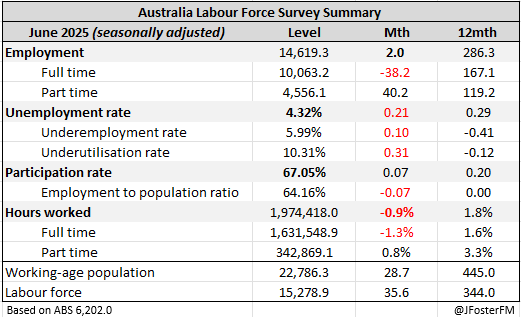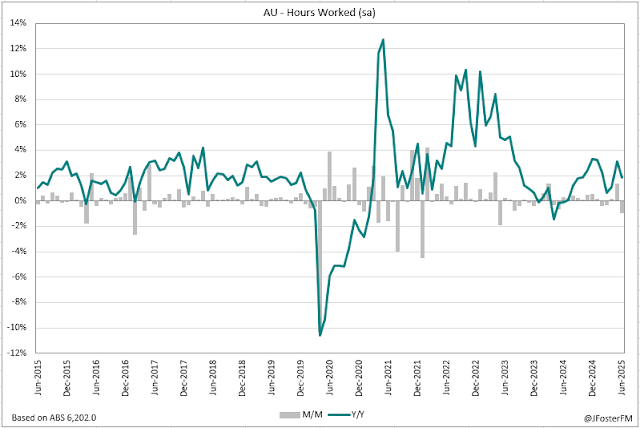The US dollar climbed this week, overcoming an earlier fall on reports President Trump was on the verge of removing Fed Chair Jay Powell. The incoming data drove the dollar higher as Fed rate-cut pricing was reduced, markets now struggling to see the Fed delivering more than one further cut by year-end. Amid a stronger dollar, the local Australian dollar underperformed on the back of weak labour market data, amplifying pressure on the RBA following its surprise decision last week to hold rates unchanged. Equities mostly advanced but were patchy in Europe. Concerns around increased supply from fiscal deficits were again in the news - this time in Japan - but bond markets were not a source of cross-market volatility this week.
Signs of tariff-driven inflation were limited in this week's US CPI data. Headline CPI printed 0.3%m/m and 2.7%yr, a touch more than expected (2.6%) and up from 2.4% prior. But that was offset by core CPI (ex-food and fuel) that came in at 0.2%m/m, the 5th consecutive below consensus outcome. The annual pace firmed from 2.8% to 2.9%, in line with forecasts. Tariff-relevant effects were seen in areas such as fresh fruit and vegetables (1%) and household appliances (1.9%), but their overall contribution to monthly inflation was modest. In addition to the CPI report, both producer (2.3%yr) and import prices (-0.2%Y/Y) indicated that tariffs have yet to meaningfully affect pricing decisions.
Meanwhile, some positive data around the US consumer came from retail sales that surprised to the upside in June. Headline sales advanced 0.6%m/m (vs 0.1%), rebounding from May's 0.9% decline. That was backed up by the control group - widely touted as a better guide of the momentum in spending - lifting by a stronger-than-expected 0.5%m/m (vs 0.3%).
UK inflation and labour market data reaffirmed the Bank of England will likely retain its 'gradual and careful' approach to its easing cycle. Upside prints revealed some of the inflation risk the BoE has been wary of as headline CPI in June lifted from 3.4% to 3.6%yr (vs 3.4%), while the core rate nudged up from 3.5% to 3.7%yr (vs 3.5%). Inflation well above the BoE's 2% target is to a large extent due to elevated inflation in services prices. On the latest read, services inflation was 4.7%yr, an unchanged pace from May but defying expectations to ease to 4.5%. Services inflation is proving sticky and is unlikely to slow materially near term, with many prices in this part of the basket government-regulated and only resetting annually or infrequently. The BoE has therefore been looking closely at the labour market as a gauge on the underlying pulse of services inflation.
The labour market is clearly cooling, but with well documented quality-related issues continuing to plague the data the BoE is going by feel. The figures that were reported showed the unemployment rate rising from 4.6% to 4.7% in May, coming on the back of a 41k fall in payrolled employment. But the drop in employment is likely to be subject to a significant revision; this week's data revised the 109k fall in employment initially reported in April to a much smaller decline of 25k. Perhaps the cleanest read on conditions is coming from earnings growth, which (excluding bonuses) slowed to an annualised pace of 5% from 5.3% previously, consistent with a softening labour market.
Next week's ECB meeting shapes as a case of steady as it goes. Downside risks to the economic outlook in the euro area are building but the expectation is the ECB will leave policy on hold. The threat of a 30% tariff hangs over European goods entering the US, unless the Trump administration and the EU can come to terms by August 1. The ECB can only set policy to what is announced, so it is waiting to see how the situation evolves, and the extent of any countermeasures that may follow. Expect the strength of the euro to be a key focus at the meeting. Typically, the ECB avoids commenting on the level of the exchange rate, but this has increasingly been a source of focus for officials from the central bank, posing downside risks to growth and inflation.
In Australia, the unemployment rate was reported to have lifted to 4.3% in June, its highest level since late 2021 after 5 consecutive months at 4.1% (reviewed here). Higher unemployment reflects the impact of employment growth slowing - not falling - with labour force participation (67.1%) around record highs. Employment put in its second consecutive flat outcome lifting by just 2k in June (vs 20k expected) after a 1.1k decline in May. Signs of softening in the labour market - if sustained - would present a strong challenge to the RBA's patient stance on rate cuts. An August RBA rate cut that the Board had seemingly tied to the June quarter inflation data looks even more likely now.










































